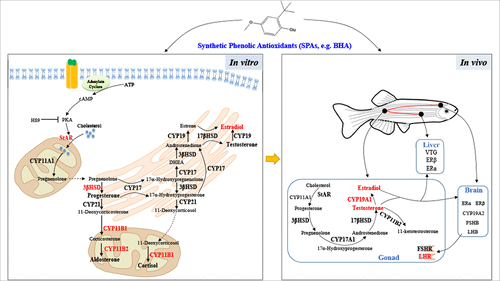当前位置:
X-MOL 学术
›
Environ. Sci. Technol.
›
论文详情
Our official English website, www.x-mol.net, welcomes your
feedback! (Note: you will need to create a separate account there.)
Synthetic Phenolic Antioxidants Cause Perturbation in Steroidogenesis in Vitro and in Vivo
Environmental Science & Technology ( IF 10.8 ) Pub Date : 2017-12-28 00:00:00 , DOI: 10.1021/acs.est.7b05057 Xiaoxi Yang 1, 2 , Wenting Song 1, 3 , Na Liu 1, 4 , Zhendong Sun 1, 2 , Ruirui Liu 1 , Qian S. Liu 1, 2 , Qunfang Zhou 1, 2 , Guibin Jiang 1, 2
Environmental Science & Technology ( IF 10.8 ) Pub Date : 2017-12-28 00:00:00 , DOI: 10.1021/acs.est.7b05057 Xiaoxi Yang 1, 2 , Wenting Song 1, 3 , Na Liu 1, 4 , Zhendong Sun 1, 2 , Ruirui Liu 1 , Qian S. Liu 1, 2 , Qunfang Zhou 1, 2 , Guibin Jiang 1, 2
Affiliation

|
Synthetic phenolic antioxidants (SPAs) are closely correlated with human life due to their extensive usages, and increasing concerns have been raised on their biosafety. The previous controversial findings caused continuous debates on their potential endocrine disrupting effects. In the present study, four commonly used SPAs, including butylated hydroxyanisole (BHA), butylated hydroxytoluene (BHT), tert-butyl hydroquinone (TBHQ) and 2,2′-methylenebis(6-tert-butyl-4-methylphenol) (AO2246), were investigated for their estrogenic effects, and the results from in vitro screening assays showed SPAs themselves had negligible estrogen receptor binding affinities. Nevertheless, significant increase in E2 secretion was observed in H295R cells treated with SPAs, especially for BHA. The transcriptional levels of steroidogenic enzymes, including StAR, 3βHSD, CYP11B1, and CYP11B2 were up-regulated via the mediation of protein kinase A (PKA) signaling pathway. In vivo experiment confirmed that waterborne exposure to BHA disturbed E2 and testosterone (T) levels in zebrafish gonad, thus causing potential estrogenic effects through the regulation of hypothalamic-pituitary–gonadal-liver axis (HPGL-axis). Accordingly, this study has provided new insights for SPA-induced endocrine disrupting effects. Considering the allowable maximum level of individual BHA or in combination with TBHQ and BHT in foodstuffs (200 mg kg–1), the perturbation in steroidogenesis observed for relatively low concentrations of SPAs would need more public attention.
中文翻译:

合成酚类抗氧化剂在体内和体外引起类固醇生成中的干扰
合成酚类抗氧化剂(SPAs)由于其广泛的用途而与人类生活密切相关,人们对其生物安全性的关注也日益增加。先前有争议的发现引起了关于其潜在内分泌干扰作用的持续争论。在本研究中,四种常用的SPA,包括丁基化羟基茴香醚(BHA),丁基化羟基甲苯(BHT),叔丁基对苯二酚(TBHQ)和2,2'-亚甲基双(6-叔丁基-4-甲基苯酚)(AO2246 ),研究了它们的雌激素作用,体外筛选试验结果表明SPA本身具有可忽略的雌激素受体结合亲和力。然而,E 2明显增加在用SPA处理的H295R细胞中,尤其是在BHA中,观察到了分泌。经由蛋白激酶A(PKA)信号通路的介导,类固醇生成酶(包括StAR,3βHSD,CYP11B1和CYP11B2)的转录水平上调。体内实验证实,水暴露于BHA会干扰斑马鱼性腺中的E 2和睾丸激素(T)水平,从而通过调节下丘脑-垂体-性腺-肝轴(HPGL-轴)引起潜在的雌激素作用。因此,该研究为SPA诱导的内分泌干扰作用提供了新的见解。考虑到食品中单个BHA或与TBHQ和BHT结合使用的最大允许量(200 mg kg –1),对于浓度相对较低的SPA观察到的类固醇生成扰动将需要更多的公众关注。
更新日期:2017-12-29
中文翻译:

合成酚类抗氧化剂在体内和体外引起类固醇生成中的干扰
合成酚类抗氧化剂(SPAs)由于其广泛的用途而与人类生活密切相关,人们对其生物安全性的关注也日益增加。先前有争议的发现引起了关于其潜在内分泌干扰作用的持续争论。在本研究中,四种常用的SPA,包括丁基化羟基茴香醚(BHA),丁基化羟基甲苯(BHT),叔丁基对苯二酚(TBHQ)和2,2'-亚甲基双(6-叔丁基-4-甲基苯酚)(AO2246 ),研究了它们的雌激素作用,体外筛选试验结果表明SPA本身具有可忽略的雌激素受体结合亲和力。然而,E 2明显增加在用SPA处理的H295R细胞中,尤其是在BHA中,观察到了分泌。经由蛋白激酶A(PKA)信号通路的介导,类固醇生成酶(包括StAR,3βHSD,CYP11B1和CYP11B2)的转录水平上调。体内实验证实,水暴露于BHA会干扰斑马鱼性腺中的E 2和睾丸激素(T)水平,从而通过调节下丘脑-垂体-性腺-肝轴(HPGL-轴)引起潜在的雌激素作用。因此,该研究为SPA诱导的内分泌干扰作用提供了新的见解。考虑到食品中单个BHA或与TBHQ和BHT结合使用的最大允许量(200 mg kg –1),对于浓度相对较低的SPA观察到的类固醇生成扰动将需要更多的公众关注。


















































 京公网安备 11010802027423号
京公网安备 11010802027423号